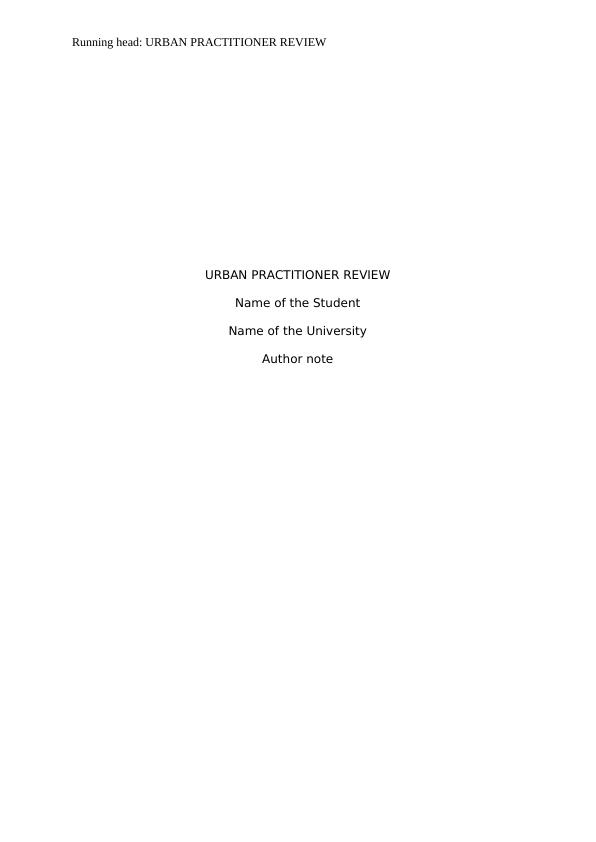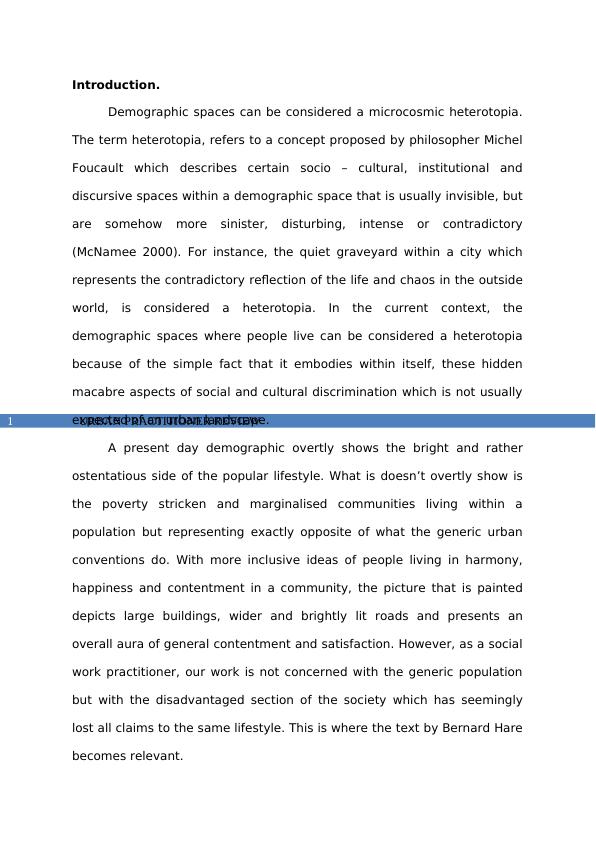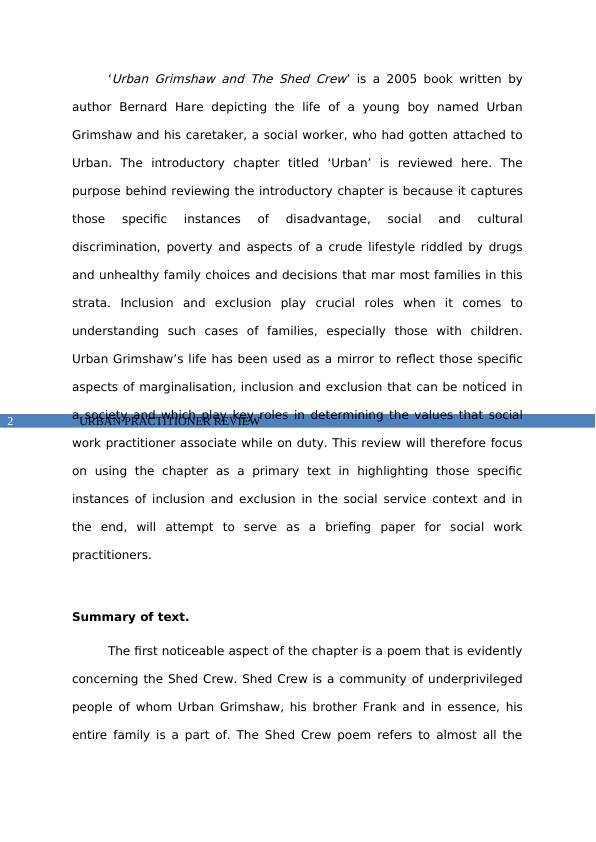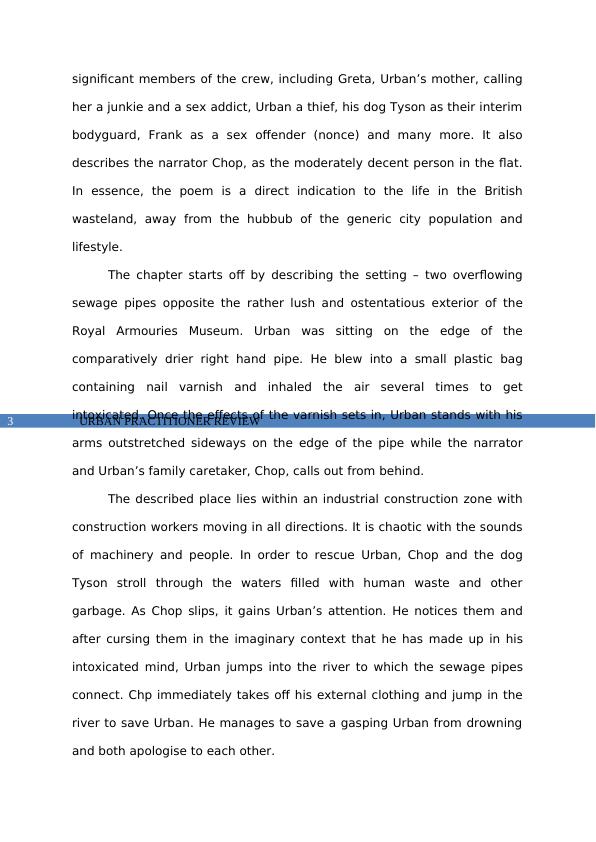Working as a Practitioner at Urban Alchemy:
Added on 2022-09-09
12 Pages3013 Words20 Views
Running head: URBAN PRACTITIONER REVIEW
URBAN PRACTITIONER REVIEW
Name of the Student
Name of the University
Author note
URBAN PRACTITIONER REVIEW
Name of the Student
Name of the University
Author note

URBAN PRACTITIONER REVIEW1
Introduction.
Demographic spaces can be considered a microcosmic heterotopia.
The term heterotopia, refers to a concept proposed by philosopher Michel
Foucault which describes certain socio – cultural, institutional and
discursive spaces within a demographic space that is usually invisible, but
are somehow more sinister, disturbing, intense or contradictory
(McNamee 2000). For instance, the quiet graveyard within a city which
represents the contradictory reflection of the life and chaos in the outside
world, is considered a heterotopia. In the current context, the
demographic spaces where people live can be considered a heterotopia
because of the simple fact that it embodies within itself, these hidden
macabre aspects of social and cultural discrimination which is not usually
expected of an urban landscape.
A present day demographic overtly shows the bright and rather
ostentatious side of the popular lifestyle. What is doesn’t overtly show is
the poverty stricken and marginalised communities living within a
population but representing exactly opposite of what the generic urban
conventions do. With more inclusive ideas of people living in harmony,
happiness and contentment in a community, the picture that is painted
depicts large buildings, wider and brightly lit roads and presents an
overall aura of general contentment and satisfaction. However, as a social
work practitioner, our work is not concerned with the generic population
but with the disadvantaged section of the society which has seemingly
lost all claims to the same lifestyle. This is where the text by Bernard Hare
becomes relevant.
Introduction.
Demographic spaces can be considered a microcosmic heterotopia.
The term heterotopia, refers to a concept proposed by philosopher Michel
Foucault which describes certain socio – cultural, institutional and
discursive spaces within a demographic space that is usually invisible, but
are somehow more sinister, disturbing, intense or contradictory
(McNamee 2000). For instance, the quiet graveyard within a city which
represents the contradictory reflection of the life and chaos in the outside
world, is considered a heterotopia. In the current context, the
demographic spaces where people live can be considered a heterotopia
because of the simple fact that it embodies within itself, these hidden
macabre aspects of social and cultural discrimination which is not usually
expected of an urban landscape.
A present day demographic overtly shows the bright and rather
ostentatious side of the popular lifestyle. What is doesn’t overtly show is
the poverty stricken and marginalised communities living within a
population but representing exactly opposite of what the generic urban
conventions do. With more inclusive ideas of people living in harmony,
happiness and contentment in a community, the picture that is painted
depicts large buildings, wider and brightly lit roads and presents an
overall aura of general contentment and satisfaction. However, as a social
work practitioner, our work is not concerned with the generic population
but with the disadvantaged section of the society which has seemingly
lost all claims to the same lifestyle. This is where the text by Bernard Hare
becomes relevant.

URBAN PRACTITIONER REVIEW2
‘
Urban Grimshaw and The Shed Crew’ is a 2005 book written by
author Bernard Hare depicting the life of a young boy named Urban
Grimshaw and his caretaker, a social worker, who had gotten attached to
Urban. The introductory chapter titled ‘Urban’ is reviewed here. The
purpose behind reviewing the introductory chapter is because it captures
those specific instances of disadvantage, social and cultural
discrimination, poverty and aspects of a crude lifestyle riddled by drugs
and unhealthy family choices and decisions that mar most families in this
strata. Inclusion and exclusion play crucial roles when it comes to
understanding such cases of families, especially those with children.
Urban Grimshaw’s life has been used as a mirror to reflect those specific
aspects of marginalisation, inclusion and exclusion that can be noticed in
a society and which play key roles in determining the values that social
work practitioner associate while on duty. This review will therefore focus
on using the chapter as a primary text in highlighting those specific
instances of inclusion and exclusion in the social service context and in
the end, will attempt to serve as a briefing paper for social work
practitioners.
Summary of text.
The first noticeable aspect of the chapter is a poem that is evidently
concerning the Shed Crew. Shed Crew is a community of underprivileged
people of whom Urban Grimshaw, his brother Frank and in essence, his
entire family is a part of. The Shed Crew poem refers to almost all the
‘
Urban Grimshaw and The Shed Crew’ is a 2005 book written by
author Bernard Hare depicting the life of a young boy named Urban
Grimshaw and his caretaker, a social worker, who had gotten attached to
Urban. The introductory chapter titled ‘Urban’ is reviewed here. The
purpose behind reviewing the introductory chapter is because it captures
those specific instances of disadvantage, social and cultural
discrimination, poverty and aspects of a crude lifestyle riddled by drugs
and unhealthy family choices and decisions that mar most families in this
strata. Inclusion and exclusion play crucial roles when it comes to
understanding such cases of families, especially those with children.
Urban Grimshaw’s life has been used as a mirror to reflect those specific
aspects of marginalisation, inclusion and exclusion that can be noticed in
a society and which play key roles in determining the values that social
work practitioner associate while on duty. This review will therefore focus
on using the chapter as a primary text in highlighting those specific
instances of inclusion and exclusion in the social service context and in
the end, will attempt to serve as a briefing paper for social work
practitioners.
Summary of text.
The first noticeable aspect of the chapter is a poem that is evidently
concerning the Shed Crew. Shed Crew is a community of underprivileged
people of whom Urban Grimshaw, his brother Frank and in essence, his
entire family is a part of. The Shed Crew poem refers to almost all the

URBAN PRACTITIONER REVIEW3
significant members of the crew, including Greta, Urban’s mother, calling
her a junkie and a sex addict, Urban a thief, his dog Tyson as their interim
bodyguard, Frank as a sex offender (nonce) and many more. It also
describes the narrator Chop, as the moderately decent person in the flat.
In essence, the poem is a direct indication to the life in the British
wasteland, away from the hubbub of the generic city population and
lifestyle.
The chapter starts off by describing the setting – two overflowing
sewage pipes opposite the rather lush and ostentatious exterior of the
Royal Armouries Museum. Urban was sitting on the edge of the
comparatively drier right hand pipe. He blew into a small plastic bag
containing nail varnish and inhaled the air several times to get
intoxicated. Once the effects of the varnish sets in, Urban stands with his
arms outstretched sideways on the edge of the pipe while the narrator
and Urban’s family caretaker, Chop, calls out from behind.
The described place lies within an industrial construction zone with
construction workers moving in all directions. It is chaotic with the sounds
of machinery and people. In order to rescue Urban, Chop and the dog
Tyson stroll through the waters filled with human waste and other
garbage. As Chop slips, it gains Urban’s attention. He notices them and
after cursing them in the imaginary context that he has made up in his
intoxicated mind, Urban jumps into the river to which the sewage pipes
connect. Chp immediately takes off his external clothing and jump in the
river to save Urban. He manages to save a gasping Urban from drowning
and both apologise to each other.
significant members of the crew, including Greta, Urban’s mother, calling
her a junkie and a sex addict, Urban a thief, his dog Tyson as their interim
bodyguard, Frank as a sex offender (nonce) and many more. It also
describes the narrator Chop, as the moderately decent person in the flat.
In essence, the poem is a direct indication to the life in the British
wasteland, away from the hubbub of the generic city population and
lifestyle.
The chapter starts off by describing the setting – two overflowing
sewage pipes opposite the rather lush and ostentatious exterior of the
Royal Armouries Museum. Urban was sitting on the edge of the
comparatively drier right hand pipe. He blew into a small plastic bag
containing nail varnish and inhaled the air several times to get
intoxicated. Once the effects of the varnish sets in, Urban stands with his
arms outstretched sideways on the edge of the pipe while the narrator
and Urban’s family caretaker, Chop, calls out from behind.
The described place lies within an industrial construction zone with
construction workers moving in all directions. It is chaotic with the sounds
of machinery and people. In order to rescue Urban, Chop and the dog
Tyson stroll through the waters filled with human waste and other
garbage. As Chop slips, it gains Urban’s attention. He notices them and
after cursing them in the imaginary context that he has made up in his
intoxicated mind, Urban jumps into the river to which the sewage pipes
connect. Chp immediately takes off his external clothing and jump in the
river to save Urban. He manages to save a gasping Urban from drowning
and both apologise to each other.

End of preview
Want to access all the pages? Upload your documents or become a member.